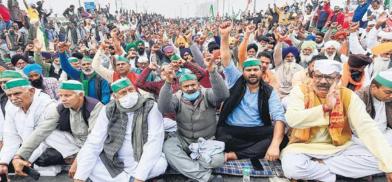Vested interest at play in India’s farmer's protests: A stormy road ahead?
In the last six years after Narendra Modi has taken over as Prime Minister of India, spectacular developments have taken place on various fronts

In the last six years after Narendra Modi has taken over as Prime Minister of India, spectacular developments have taken place on various fronts. In the field of science and technology, India’s achievements in space technology, development of COVID-19 vaccines, the rapid increase in production of renewable energy (solar and wind power) has made the world look at India more closely.
On the socio-economic front too, several innovative schemes such as opening bank accounts for every poor person in India, construction of houses for poor people, providing LPG cooking gas for all households and so many other schemes are laudable. In the cultural front too, making yoga internationally known and persuading the United Nations to declare one day in a year as Yoga day are some of the very impressive achievements.
It is a fact that several earlier governments too have implemented some progressive measures, which have been duly recognized.
Several more reform measures in the agricultural, financial and social spheres are required to enable India to forge ahead and occupy the rightful place that it deserves in the global arena.
One of the important measures initiated by the Modi government is to introduce agricultural reform measures. These reform measures were those which several agricultural economists and agriculturists themselves have been demanding for over three decades. These reform measures are a much-discussed subject.
Modi has the courage to take the bull by the horn to introduce this reform measures in the agricultural sector. Any reform measure in any sphere would inevitably lead to a situation where those enjoying privileged positions for several decades would be impacted and they would be displeased. But, these measures are needed to ensure the equidistribution of opportunities to everyone involved in agricultural operations and ensures that the farmers would not be exploited by middlemen and traders and they would get the appropriate price and reasonable profit for the hard work.
India is reported to have around one hundred and fifty million farmers, who directly own land and use it for farming. Apart from the owners of agricultural land, there are several other tillers (farmworkers getting wages) who work on the land. Most of these genuine and real farmers are happy with the recent agricultural reform measures introduced by the Modi government as is evident from the fact that they are not participating in any protest against reform measures and are doing their duty by working on the land every day.
It is known that those who are protesting against the agricultural reform measures are traders and middlemen in two states namely Punjab and Haryana, who have been sitting pretty for the last several decades making a huge profit by trading in agricultural products, which inevitably have affected the income of the farming community.
These middlemen have the money power and staying power and they are the first sponsors of the protest against the reform measures introduced by the Modi government.
Of course, with their money power, they can always bring crowds, by enticing the people and perhaps, carrying out false propaganda.
While the rich middlemen and traders from Punjab and Haryana call themselves farmers, which they are not and organize the protest, several so-called activists, opposition political parties and some separatist groups and of course, some overseas agencies, who all share a common hatred for Modi as a person and his government, have joined the bandwagon.
The countrymen representing the cross-section of society are highly disturbed about this protest which is inconveniencing the people, particularly in the national capital Delhi.
The Modi government has been handling this protest as patiently as possible and has now offered to suspend the implementation of reform measures for eighteen months, so that the measures can be discussed in a calm atmosphere and solutions can be found.
However, the so-called farmers and instigators in India and abroad (they have their own agenda and have vested interests) are not listening to reason and they say that they would continue the protest at any cost. Of course, sections of media give them huge publicity.
On 26th January, India’s Republic Day, the protesting crowd entered Delhi from the border states of Punjab and Haryana and created chaotic and violent conditions and damaged the Red Fort, which is one of India’s historical monuments.
Now, these protesting crowds backed by instigators are threatening to repeat the ‘invasion of Delhi’ on February 6, 2021, causing huge apprehensions and concern all over India.
When the Government of India uses barbed wire, spikes, and trenchers to cut off the protest sites and prevent the crowd from entering Delhi to prevent violence and further disconnected the internet service, there is a protest from the so-called farmers and their supporters.
What else can a government do?
Now, it is clear that the protests are due to political reasons and the objective of the so-called farmers and section of opposition political parties and a section of activists and overseas organisations are the same and they want to destabilize the country and settle scores with the Modi government and cause chaotic conditions in India. They have chosen India’s capital Delhi as the venue for their game plan.
As has been seen in the past, several media agencies abroad and some activists motivated against India and some senators in the USA, and some MPs in UK and Canada seems to be happy about the conditions in India and they make comments about so-called human rights violations and provide false information about the death of the protesters. They go to the familiar theme that human rights violation has taken place in India. Obviously, they have no knowledge about the ground realities in India and have made themselves as willing tools to serve vested interests.
Now, what next?
Many people in India think that the objective of the protesters and vested interests is to create violent conditions, forcing police to fire on them which could result in the death of some. This could be the opportunity that the protesters and the vested interests are looking for. Then, their propaganda campaign would become much more intense and the government would be forced to take some drastic measures to enforce law and order.
The protesters and the vested interests would be happy if the Modi government would enforce a national emergency to put down the violent conditions.
Obviously, the so-called farmers, a section of politicians and activists with vested interests are playing a dangerous game.
(The writer is a Trustee, NGO Nandini Voice for the Deprived, Chennai. The views are personal. He can be contacted at nsvenkatchennai@gmail.com)










Post a Comment